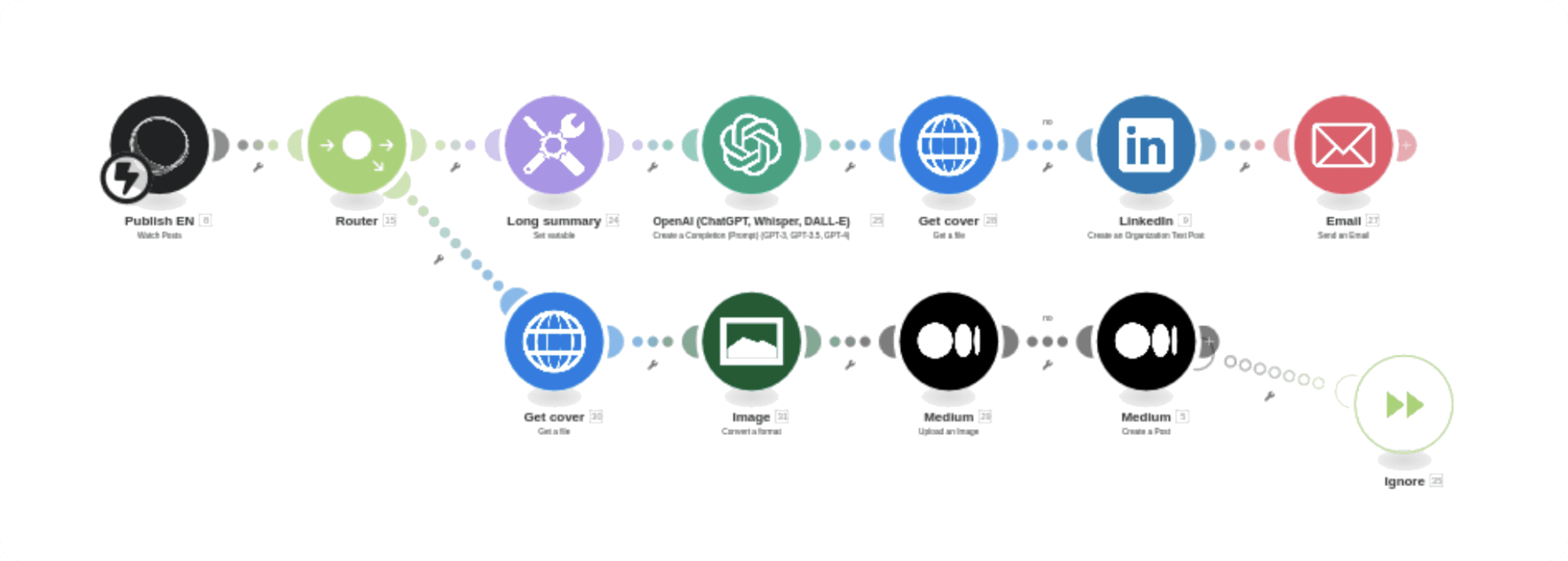May 23, 2025 | 5 minutes
How to use AI to translate and localize websites and blogs
Reap the benefits of entering new markets without the added costs. Follow Velocity Flow's guide to translating, localizing, and posting your content internationally – and automatically.

For fast-growing brands expanding into new regions, localized websites are essential for winning trust, ranking high in search results, and engaging with new audiences.
But when localization needs to be done at scale, how do you publish and manage content across multiple SEO-optimized websites and in multiple languages without adding complexity? And in today's tight economy, how do you benefit from new markets without raising overheads like hiring new team members or relying on local agencies?
The answer is to combine automation with AI using Make, and media technology experts Velocity Flow have already proven it’s possible. In a recent Make webinar, Velocity Flow laid out in detail the AI-driven Make scenarios they employed to help their client SpazioCrypto launch and run eight localized websites – simultaneously and automatically.
Each site loads fast, ranks well, and stays in sync with new content, while still resulting in an 80% cost saving every month. Here's how they did it.
The problem
SpazioCrypto is a fast-growing crypto education and news platform. As its audience expanded globally, the team needed to publish content in more languages – but they ran into major issues with its existing setup, which was built with dynamic translation plugins.
The issues included:
Slow page speeds: Pages would take 10+ seconds to load, which is well below the ideal of 3.8 seconds.
Poor quality: The context of the machine translations was often ‘off’ and there was no easy way to review it.
SEO issues: Metadata and sitemaps weren’t optimized properly.
Velocity Flow (previously known as GhostFlow) founder Magnus Helander says: “Google requires websites to be useful within 3.8 seconds – so 10 plus seconds on the existing SpazioCrypto sites wasn’t going to work. The dynamic translation solution also created problems for external embedded content such as currency tickers, video embeds, and cookie scripts.”
The tools
To solve these problems, Velocity Flow, a Make Silver Partner, built a localization engine with Make. This required a range of tools and Make apps, including:
A content management system (CMS) with an API: Velocity Flow demonstrated using the very common WordPress
DeepL: For AI-powered translation
Claude AI: For rewriting content summaries for specific audiences
Various custom webhooks
Bing (IndexNow) + Google Search Console: For SEO indexing
Social media: X, Facebook, LinkedIn, Medium, Telegram, and Instagram
It's important to note that Velocity Flow’s choice of apps isn’t prescriptive. It’s easy to adapt these scenarios to your stack, such as substituting Ghost CMS, Google Translate, or ChatGPT where appropriate.
Connect anything
Make supports 2,000+ pre-built apps, including 300+ AI apps. Don't have the app you need? Make also offers the flexibility of integrating anything with an API.
Magnus says: “We came up with a solution using Make and AI that delivered the loading speed we wanted along with a great user experience and great SEO. The setup means SpazioCrypto has the freedom to scale localization to any number of websites, with simple linear cost increases as individual languages are added.”
The setup
The localization system was built using three Make scenarios, each focused on a specific task.
Together, they power an end-to-end workflow that:
Detects new content
Translates it into eight languages
Publishes each version to its own CMS instance
Indexes the content for search engines to discover
Shares it on social media with channel-appropriate summaries
Scenario 1: Translation and CMS integration
This is the heart of the whole automation. It all starts when a new SpazioCrypto post is published, in this case in Italian, and a custom webhook notifies Make.
These are the steps Magnus demonstrates during the webinar:
The post content and metadata are sent to Make
Make’s text parser function strips the HTML to prepare the content for translation
The title and body are each translated using DeepL
Make publishes the translated content to each CMS (eight in total), tagging each post and setting publish status
Email notifications are triggered
Magnus says: “All this happens in less than 30 seconds. We actually throttle it to avoid overloading. It’s that fast.”
Scenario 2: SEO and indexing
To rank well in different markets, translated pages need more than just translated content. Vital metadata – page titles, URL slugs, alt tags, sitemaps, and more – must be localized too.
Velocity Flow automated all of this with Make using these steps:
The translated post’s metadata is generated automatically
Each CMS entry gets its own sitemap in its own language
Language-switching URLs are registered in a shared lookup table
Hreflang tags (an HTML attribute used to indicate the language of a webpage) are generated dynamically to tell search engines which version of the page to show
Every new post is indexed using IndexNow (to submit to Bing) and Google Search Console (to submit to Google)
🎥 Check it out on video
Watch the full webinar to start recreating the blueprints Velocity Flow uses for these scenarios.
Magnus says: “We translate everything – the title, the URL, all tags, excerpts, categories – and we have unique sitemaps for each language. It turned out really, really nice.”
Scenario 3: Social media sharing
Once content is live, it needs to reach the right audiences. Velocity Flow also used Make and AI to write and publish social media posts in the relevant language to distribute the newly translated content.
This final scenario, as demonstrated during the full webinar, included the following steps:
A well-structured prompt is sent to Claude asking it to rewrite the post in a specific tone and structure
HTML is returned with formatted headings and summaries
The AI output is posted automatically to each social media account (in the correct language)
As an optional extra step, a version of every post can also be sent via email or newsletter
The fully-translated and search optimized websites are delivering an impressive 80% cost saving every month, compared to using dynamic translators such as WeGlot or Lokalise.
Magnus says: “It looks really, really good – and the cost savings were a fantastic surprise.”
How AI helps
This example proves that combining AI and automation is the only realistic approach when cost-effective localization at scale is required. AI improves both quality and reach, producing context-aware translations you can edit and rewriting content to suit different audiences and platforms.
By combining Make’s flexibility with the power of an LLM, Velocity Flow helped SpazioCrypto localize faster and deliver peak experiences for audiences across markets. This was achieved without requiring new hires, adding manual work for the existing team, or enlisting expensive local agencies – in other words, translation costs were cut by 80%.
Magnus says: “There’s no way to achieve this level of performance and control with dynamic translation.”
Do more with Make and AI
Learn more about AI automation with Make here and sign up for a free account to start automating today.






